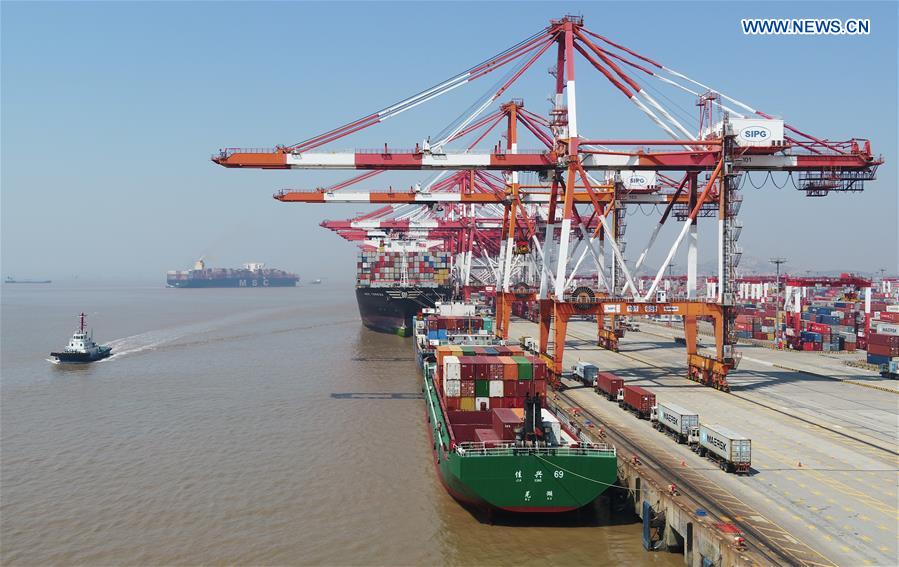

At the site of phase IV of the Yangshan Deep Water Port in Shanghai, east China, a crane is busy hoisting containers, an indication that the port’s usual hustle and bustle has returned.
Due to the impact of the COVID-19 epidemic, the volume of containers handled by the port was down by 8.4 percent year on year in the first four months of 2020. Today, the world’s largest automated terminal is back to its previous busy self, with container throughput hitting a new peak of 43.5 million 20-foot equivalent units (TEUs) in 2020.

Aerial photo taken on March 18, 2020 shows the container dock of Yangshan Port in Shanghai, east China. The international container port saw an increasing flow of cargo ships during the past two weeks. (Xinhua/Ding Ting)
And it’s not the only one - container terminals in major cities, including Ningbo in east China’s Zhejiang province, Tianjin in north China, Qingdao in east China and Dalian in northeast China, and freight containers transported by trains, have all come back to life.
In 2020, freight trains made over 10,000 trips between China and Europe, transporting epidemic prevention materials, automobile parts and electronic products from China to other countries.
Statistics showed that the China containerized freight index reached 1,863.84 points in mid-January 2021, about 1,000 points higher compared with the average figure reported in May 2020.
The recovery of container throughput signals the rapid recovery of the Chinese economy. While the global trade of goods dropped by 5.6 percent year on year in 2020 due to the COVID-19 pandemic, China's total goods imports and exports reached 32.16 trillion yuan (about $5 trillion), hitting a record high.
The strong recovery in foreign trade is not only supported by international logistics with containers as the carrier, but also relies on a stable industrial chain and supply chain. For example, exports can only meet international market demand when the supply side goes all-out, and the upstream and downstream on the supply chain work together.
In Guangdong, a foreign trade enterprise manufacturing electrical appliances has been operating at full capacity, thanks to the hard work of all the employees and the strong cooperation of suppliers.
Relying on the ultra-large market and comprehensive industrial system, Chinese enterprises have quickly solved issues such as inadequate supply of raw materials and poor connectivity between domestic and overseas logistics networks, ensured the recovery of all links on the industrial chain and supply chain, and laid a solid foundation for the recovery of foreign trade.
Scientific decision-making and creativity are the fundamental ways to transform crises into opportunities, according to the annual Central Economic Work Conference held in December 2020.
From making major strategic achievements in the fight against the COVID-19 epidemic and promoting the resumption of work and production to improving the export tax rebate policy and stepping up credit support for foreign trade firms, China has implemented precise policies to lead its foreign trade to cushion the impact of the epidemic.
After eight years of negotiations, the Regional Comprehensive Economic Partnership (RCEP) was signed in 2020 against the backdrop of the COVID-19 pandemic. As an important platform to facilitate opening up, the agreement is set to improve foreign trade and China’s free trade zone strategy.
Faced with rapid restructuring of the global industrial chain and risks brought by the pandemic, there are still many uncertainties ahead for China’s foreign trade. However, as long as the country continues to pursue opening up, it will be able to consolidate the advantages of its foreign trade, expand the space for development, and push its economy toward greater success through promoting sound interaction between the domestic and international markets.
 Fire brigade in Shanghai holds group wedding
Fire brigade in Shanghai holds group wedding Tourists enjoy ice sculptures in Datan Town, north China
Tourists enjoy ice sculptures in Datan Town, north China Sunset scenery of Dayan Pagoda in Xi'an
Sunset scenery of Dayan Pagoda in Xi'an Tourists have fun at scenic spot in Nanlong Town, NW China
Tourists have fun at scenic spot in Nanlong Town, NW China Harbin attracts tourists by making best use of ice in winter
Harbin attracts tourists by making best use of ice in winter In pics: FIS Alpine Ski Women's World Cup Slalom
In pics: FIS Alpine Ski Women's World Cup Slalom Black-necked cranes rest at reservoir in Lhunzhub County, Lhasa
Black-necked cranes rest at reservoir in Lhunzhub County, Lhasa China's FAST telescope will be available to foreign scientists in April
China's FAST telescope will be available to foreign scientists in April "She power" plays indispensable role in poverty alleviation
"She power" plays indispensable role in poverty alleviation Top 10 world news events of People's Daily in 2020
Top 10 world news events of People's Daily in 2020 Top 10 China news events of People's Daily in 2020
Top 10 China news events of People's Daily in 2020 Top 10 media buzzwords of 2020
Top 10 media buzzwords of 2020 Year-ender:10 major tourism stories of 2020
Year-ender:10 major tourism stories of 2020 No interference in Venezuelan issues
No interference in Venezuelan issues
 Biz prepares for trade spat
Biz prepares for trade spat
 Broadcasting Continent
Broadcasting Continent Australia wins Chinese CEOs as US loses
Australia wins Chinese CEOs as US loses